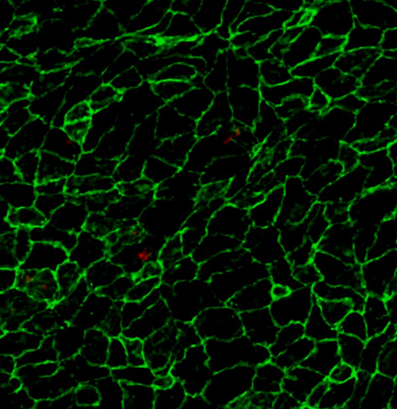
Dr. Alicia G. Arroyo, recently incorporated to the Molecular Biomedicine Department at Centro de Investigaciones Biológicas with a research line focused on Matrix metalloproteinases in angiogenesis and inflammation, together with her group has identified the protease MT4-MMP as the first target whose blocking increases the crawling activity of circulating patrolling monocytes. This study, published in Nature Communications journal, was performed in the laboratory that Dr. Arroyo led at Centro Nacional de Investigaciones Cardiovasculares (CNIC) with the participation of other researchers from CNIC, IIBB-CSIC (Barcelona) and the University of Tokyo.
Our immune defense system includes different types of circulating leukocytes endowed with specific functions. Inflammatory monocytes quickly respond to tissue damage extravasating from the bloodstream. The other monocyte subset is in charge of crawling and surveying the inner part of the vessels, and they are named patrolling monocytes. These monocytes extravasate rarely to the damaged tissues and therefore their role in inflammation was less understood.
In this work, Dr. Arroyo’s group has deepened our understanding on the function of patrolling monocytes in inflammatory disease as well as on the mechanisms which regulate their intravascular crawling activity. For that, atherosclerosis was selected as the model of inflammation. This is a chronic inflammatory disease of the arteries that affects a high percentage of people and is responsible for most myocardial infarction events. In atherosclerosis, the damage signal in the vessel wall is produced by cholesterol deposit which induces the recruitment of inflammatory monocytes, and at a lower extent, of patrolling monocytes. Once in the vessel wall, monocytes differentiate to macrophages, cells expert in engulfing and accumulating cholesterol.
The authors observed that in the absence of the protease MT4-MMP, from the matrix metalloproteinase family, there was increased macrophage abundance in the plaques and atherosclerosis was accelerated in mice fed a high fat diet. Moreover, in early lesions the lack of MT4-MMP enhanced selectively the recruitment of patrolling monocytes but not of the inflammatory monocytes. In the plaque, these patrolling monocytes gave rise to macrophages which accumulated more lipids and survived better.
The international team of researchers discovered that the treatment of MT4-MMP-deficient mice with the drug Maraviroc (used in HIV patients) blocked the recruitment of patrolling monocytes to the plaque and hindered macrophage accumulation and acceleration of atherosclerosis. Moreover, they found that the protease MT4-MMP is able to cleave a receptor key for leukocyte adhesion, the αM integrin, so that in the absence of the protease this receptor gets accumulated at the cell surface of patrolling monocytes. To visualize the unique crawling activity of these cells, the authors performed intravital microscopy observing that the number of patrolling monocytes which crawled on the inflamed endothelium was increased in mice lacking MT4-MMP.
These findings can have clinical implications, since although the increase in patrolling monocyte activity by targeting MT4-MMP might accelerate atherosclerosis, it can also facilitate the removal of foreign particles in the bloodstream as pathogens or circulating tumor cells. Thus, the study opens new opportunities for improving the treatment of infections or preventing tumor metastasis.
Reference: MT4-MMP deficiency increases patrolling monocyte recruitment to early lesions and accelerates atherosclerosis. Cristina Clemente, Cristina Rius, Laura Alonso-Herranz, Mara Martín-Alonso, Ángela Pollán, Emilio Camafeita, Fernando Martínez, Rubén A. Mota, Vanessa Núñez, Cristina Rodríguez, Motoharu Seiki, José Martínez-González, Vicente Andrés, Mercedes Ricote, and Alicia G. Arroyo. Nature Commun. 9, Article number: 910 (2018). doi:10.1038/s41467-018-03351-4

